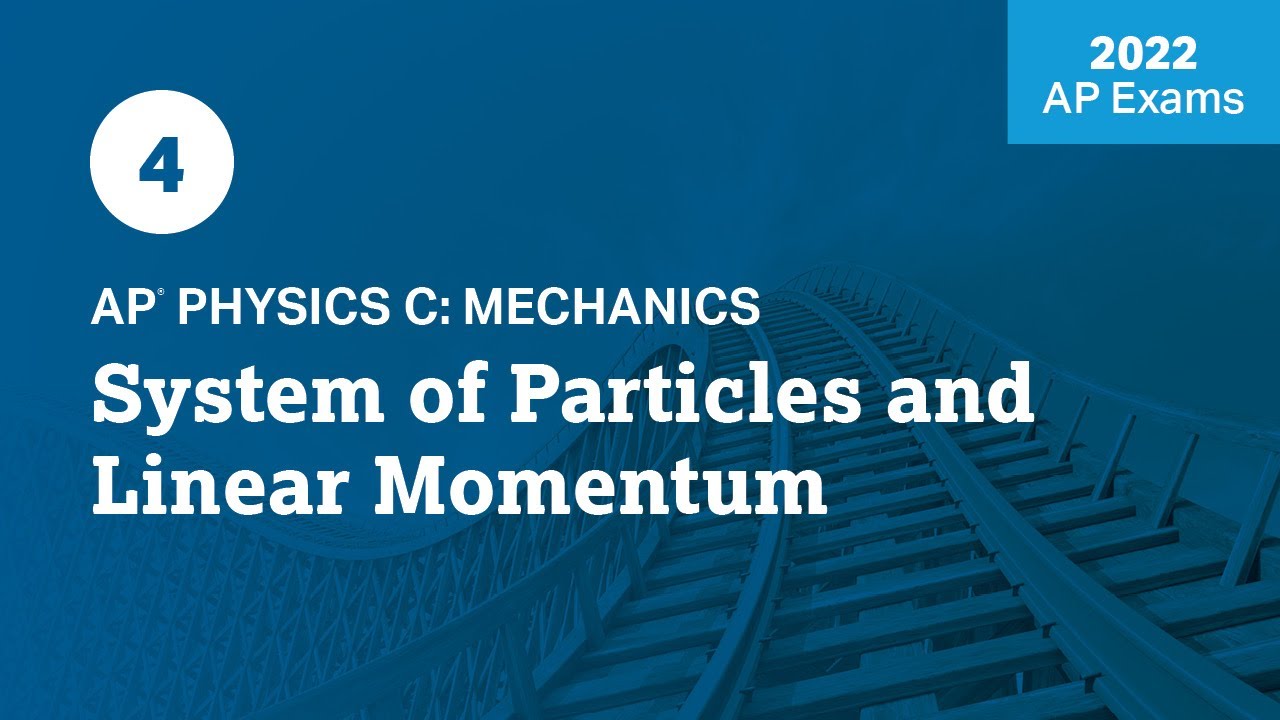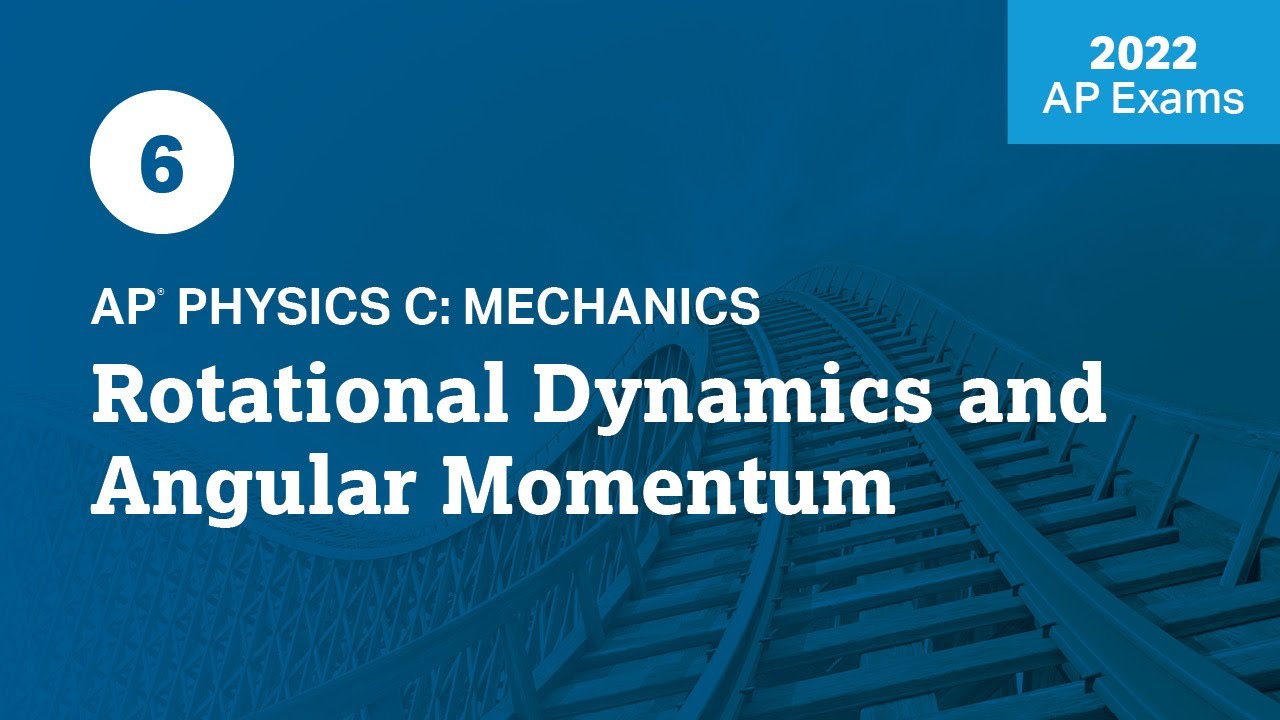3 | FRQ | Practice Sessions | AP Physics C: Mechanics
TLDRIn this educational video, Dr. Julie Hood from MAST Academy in Miami, Florida, guides viewers through a complex physics problem involving rotational motion of a uniform rod. The problem, devoid of numerical values, requires the calculation of rotational inertia, linear speed at the rod's bottom end, and the period of oscillation using variables and fundamental constants. Dr. Hood emphasizes the importance of applying conservation of energy and understanding the relationship between simple and physical pendulums, providing a comprehensive approach to solving the problem.
Takeaways
- 📚 Dr. Julie Hood is an AP Physics teacher from MAST Academy in Miami, Florida, presenting a rotational motion problem involving variables instead of numbers.
- 🔗 The video offers a downloadable PDF for viewers to work through the problem alongside the presentation.
- 🌟 The problem involves a uniform rod of mass 'm' and length 'l' pivoted at a point one-third of its length from the left end.
- 📐 The task is to calculate the rotational inertia of the rod about the pivot, the linear speed at the rod's bottom end when vertical, and the period of oscillation when slightly displaced from the vertical position.
- 🧩 The problem requires the application of principles of conservation of energy and the calculation of moments of inertia, specifically for a rod pivoted away from its center of mass.
- 📘 The moment of inertia for the rod about the pivot is calculated using integral calculus, resulting in \( \frac{1}{9}ml^2 \).
- 🔄 The parallel axis theorem is mentioned, but the focus is on deriving the moment of inertia through calculus for a comprehensive understanding.
- ⚡ To find the linear speed of the rod's bottom end as it passes through the vertical, energy conservation principles are applied, leading to the formula \( 2\sqrt{\frac{gl}{3}} \).
- 🌀 The period of oscillation for the rod when it acts as a physical pendulum is derived, highlighting the difference from a simple pendulum.
- 📉 The average score on this problem was low, indicating its complexity and the importance of understanding the concepts rather than memorizing formulas.
- 📝 Dr. Hood emphasizes the importance of writing down the correct equations relevant to the problem to earn points, especially when dealing with moment of inertia calculations.
Q & A
What is the main topic of the video?
-The main topic of the video is to work through a rotational motion free response question involving a uniform rod, focusing on calculating rotational inertia, linear speed at the bottom end of the rod, and the period of oscillation as it swings.
Who is the presenter of the video?
-The presenter of the video is Dr. Julie Hood, an AP Physics teacher from MAST Academy in Miami, Florida.
What is the mass and length of the rod mentioned in the script?
-The rod has a mass 'm' and a length 'l', but the specific numerical values are not provided as the problem is solved using variables.
Where is the pivot point located in relation to the rod?
-The pivot point is located at a distance of 'l/3' from the left end of the rod.
What fundamental constants are mentioned in the script for solving the problem?
-The fundamental constants mentioned are the acceleration of gravity 'g' and the universal gravitational constant 'big G'.
What is the formula for calculating the moment of inertia of the rod about the pivot?
-The moment of inertia of the rod about the pivot is calculated using the integral calculus formula and is found to be '1/9 ml^2'.
Why is the parallel axis theorem not recommended for this problem if integral calculus is required?
-The parallel axis theorem is not recommended because if the problem explicitly asks for the use of integral calculus, using the theorem may not earn points as it bypasses the calculus requirement.
How is the linear speed at the bottom end of the rod calculated when it passes through the vertical position?
-The linear speed is calculated using the conservation of energy principle, where potential energy is converted to kinetic rotational energy, and the relationship between angular velocity (omega) and linear speed (v) is utilized.
What is the formula for the period of oscillation of a simple pendulum?
-The formula for the period of oscillation of a simple pendulum is '2π√(L/g)', where 'L' is the length of the pendulum and 'g' is the acceleration due to gravity.
How does the formula for the period of a physical pendulum differ from that of a simple pendulum?
-The formula for the period of a physical pendulum involves the moment of inertia and the distance from the pivot point to the center of mass, and is given by '2π√(2l/3g)', where 'l' is the length of the rod and 'g' is the acceleration due to gravity.
What is the average score of students on this problem, as mentioned in the script?
-The average score of students on this problem was 2.9 points out of 15.
What advice does Dr. Hood give for approaching problems involving objects in motion, such as bouncing, falling, or rotating?
-Dr. Hood advises to approach such problems using the conservation of energy principle, and if the situation is static, to use forces.
Outlines
📚 Introduction to Rotational Motion Problem
Dr. Julie Hood introduces a physics problem involving rotational motion without numerical values, focusing on variables. She invites viewers to download a PDF of the problem and explains the scenario involving a uniform rod of mass 'm' and length 'l' pivoted at a point one-third of the length from the left end. The goal is to calculate the rod's rotational inertia about the pivot, its linear speed at the bottom end when vertical, and the period of oscillation when slightly displaced from the vertical position. The problem requires understanding of fundamental constants, moment of inertia, conservation of energy, and pendulum dynamics.
🔍 Calculating Moment of Inertia and Linear Speed
The second paragraph delves into the process of calculating the moment of inertia of the rod about the pivot using integral calculus, emphasizing the importance of the mass-to-length ratio and the limits of integration. Dr. Hood explains how to find the moment of inertia at the center of mass and then adjust for the pivot's offset. She then addresses the calculation of the rod's linear speed at the bottom end when it passes through the vertical position by applying the conservation of energy principle. The process involves converting potential energy to kinetic rotational energy and using the relationship between angular velocity and linear speed at a distance from the pivot.
🌐 Determining the Period of Oscillation for a Physical Pendulum
In the final paragraph, Dr. Hood discusses the calculation of the period of oscillation for the rod when it is displaced slightly from its vertical resting position. She contrasts this with the period of a simple pendulum and introduces the formula for a physical pendulum, which accounts for the extended mass and the distance of the center of mass from the pivot point. The summary includes the derivation of the formula, emphasizing the need to match units and the importance of the moment of inertia and distance from the pivot in the calculation. She concludes with advice on common student errors and the importance of using the correct equations and methods for solving physics problems.
Mindmap
Keywords
💡Rotational Motion
💡Moment of Inertia
💡Conservation of Energy
💡Linear Speed
💡Period of Oscillation
💡Uniform Rod
💡Pivot
💡Fundamental Constants
💡Integral Calculus
💡Parallel Axis Theorem
💡Physical Pendulum
Highlights
Introduction to a rotational motion free response question with variables, no numerical values.
The problem involves a uniform rod of mass 'm' and length 'l' attached to a pivot.
The pivot is located at a specific distance from the rod's end, influencing the calculations.
The task is to calculate the rotational inertia of the rod about the pivot in terms of given quantities and fundamental constants.
Explanation of the need to answer the problem using integral calculus rather than the parallel axis theorem for full points.
Demonstration of how to find the moment of inertia with respect to the pivot using an integral approach.
Derivation of the moment of inertia formula \( \frac{1}{9} ml^2 \) for the rod about the pivot.
Clarification on the use of the parallel axis theorem and its limitations in this context.
Application of conservation of energy principles to calculate the linear speed of the rod's bottom end when it passes through vertical.
Relating angular velocity 'omega' to linear speed 'v' for the calculation of the rod's speed.
Derivation of the formula for the linear speed of the rod's bottom end, \( 2\sqrt{\frac{gl}{3}} \).
Transition to the calculation of the period of oscillation for the rod when it is displaced from the vertical position.
Introduction to the concept of a physical pendulum and its relation to a simple pendulum.
Explanation of the formula for the period of oscillation of a physical pendulum.
Derivation of the period of oscillation formula for the rod, \( 2\pi\sqrt{\frac{2l}{3g}} \).
Analysis of common student errors and advice on how to approach the problem effectively.
Emphasis on the importance of using the correct formula and method to solve for moment of inertia.
Advice on utilizing conservation of energy for problems involving motion, rotation, and oscillation.
Encouragement to review the connection between simple and physical pendulums for a deeper understanding.
Transcripts
Browse More Related Video

1 | MCQ | Practice Sessions | AP Physics C: Mechanics

2022 Live Review 4 | AP Physics C: Mechanics | System of Particles and Linear Momentum

AP Daily: AP Physics C: Mechanics (1.1)

2 | FRQ | Practice Sessions | AP Physics C: Mechanics

2022 Live Review 6 | AP Physics C: Mechanics | Rotational Dynamics and Angular Momentum

7 | FRQ | Practice Sessions | AP Physics C: Mechanics
5.0 / 5 (0 votes)
Thanks for rating: